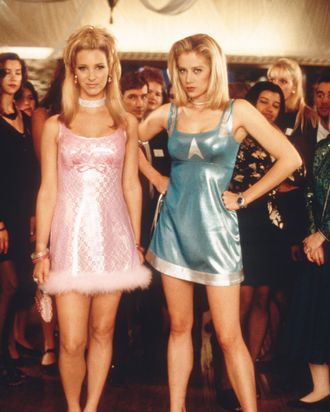
Romy and Michele’s High School Reunion turns 25 this month, and so, in honor of the anniversary, I convinced my best friend from high school, Rebekah, the person who made me watch it in the early 2000s, to rewatch the movie with me (in different states, pausing to call each other during and after) to see if it held up.
“Dude, oh my God. It was like putting on an old, worn-in pair of shoes,” she laughs when I ask her how it felt to rewatch the film after a decade or more.
Released in 1997, Romy and Michele is part of the buddy-comedy canon, but unlike Wayne’s World or the male-centric films that often define the genre, Romy and Michele is about two women: blonde, ditsy, unapologetically femme. (The New York Times review at the time called them “bimbo Bill and Ted”.)
A plot refresher: Two best friends from high school learn about their ten-year high-school reunion and devise an ill-conceived plan to show up their fellow students — classic teen revenge fantasy. The friendship chemistry between Romy (Mira Sorvino) and Michele (Lisa Kudrow) is palpable. (So is their comedic timing. And their outfits.) We are supposed to buy that these two conventionally attractive women were high-school underdogs, and their strategy to impress their class is cringeworthy, replete with homemade business suits, a fancy borrowed car, a flip phone, and a last-minute decision to claim they invented Post-its.
Rebekah and I first watched Romy and Michele in the early 2000s when we were living together in Oakland, California. We can’t remember exactly when, but Rebekah does remember we rented it from Netflix’s new DVD service. The two of us met a decade earlier, at the start of seventh grade, and became fast friends. She was a boy-crazy, pop-culture-obsessed mixed-race Black girl with a bedroom plastered with pictures of Keanu Reeves. I was a dorky rebel, carrying the baggage of being mercilessly teased for being Indian in elementary school. Rebekah, with the help of our other friend Danielle, taught me about makeup and how to brush my hair. They reassured me that the people in our school knew nothing and that I was “pretty like Seventeen magazine.”
By the time we got to high school, we had gotten closer and formed a ragtag group of weirdos — a safe space in a sea of hostile sameness. We felt plagued by corny cheerleaders and football players at our predominantly white school. “I got upset again when Christie Masters sticks magnets on Michele’s back brace in high school,” Rebekah says. I tell her that scene in the movie also made me upset, reminding me how much we felt like outsiders. “That’s why we loved the movie so much,” Rebekah says. “We knew these were the bad years and things would only get better.”
Like Romy and Michele, we felt looked-over in high school, not in the A, B, or C group. Still, I tell Rebekah, like Michele confesses to Romy, that I don’t remember us being upset that we weren’t popular at the time. “Well, that’s true, except for boys. I really related to Romy having a crush on the most popular boy in school and him being like, ‘Ew.’ That really hit hard,” Rebekah responds.
In some ways, the movie was about our generation — Gen X, the first generation that didn’t get married right after college. They were in their late 20s, and they hadn’t figured out their lives yet. Or, as Rebekah puts it, “They were really content with the lives that were given to them. They weren’t too ambitious.”
Romy and Michele takes us back to a time when young people had less pressure on them to have it all figured out immediately upon hitting the real world. Perhaps it was even progressive to have two women be okay with not being hyperproductive, successful, or in relationships — just crazy about each other and the universe they created within that bubble of love.
“It’s such an ideal representation of female friendship,” Rebekah says. “I miss that best friend that you can talk to about anything. We don’t do that anymore the way that we used to.”
This is where I remind her that we actually do talk all the time, but she is right, of course. In real life, friendship bubbles burst quickly once you marry and have children or life takes you to other places. Rebekah is a filmmaker now and lives in Denver with her son and husband. I am a writer splitting my time between New York City and upstate. We’re still close, but we don’t see each other or talk as much as we did when we were young.
Romy and Michele has maintained its status as a cult classic for over two decades not because it is one of the greatest films of our time — although it did have one of the longest dream sequences in modern cinema and a truly all-star cast (Kudrow and Sorvino are joined by Alan Cumming, Janeane Garofalo, and Justin Theroux) — but because it is a love letter to the transformative power of friendship.
My relationship with Rebekah, like many of my good friendships, has transcended time and place and has also weathered the ups and downs of any 30-plus-year relationship, including breakups, career changes, marriages, and deaths.
“I’M THE MARY,” she used to shout at me, mimicking Michele infamously telling Romy she’s the “cuter one” while referencing another iconic best-friend duo, Mary and Rhoda from The Mary Tyler Moore Show, when we’d get ready to go out. We laugh remembering this.
“We were both really cute, though,” she says.






